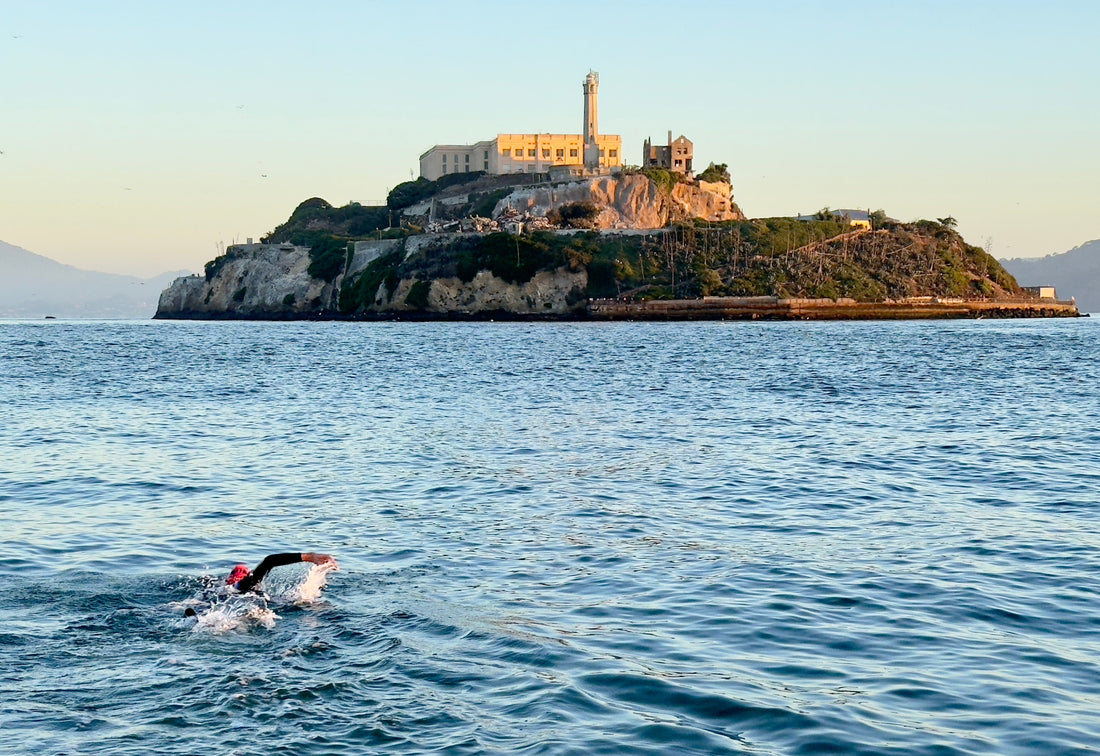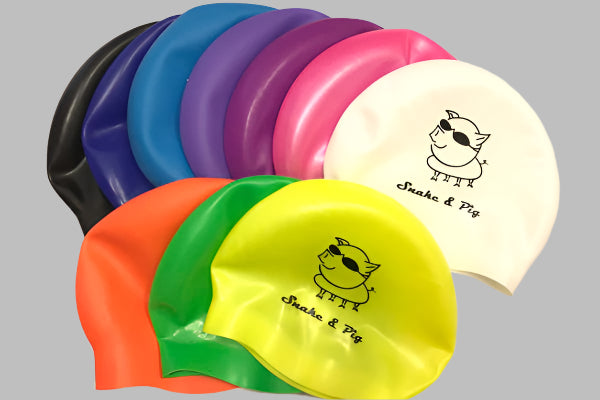
Swimming San Francisco Bay
You may have swum in rivers or lakes, or in the ocean beyond the breakers. But have you swum the dark, chilly waters of the San Francisco Bay past Alcatraz or the Golden Gate Bridge?
If a bay swim has been on your bucket list, it’s important to chose a good group to swim with. With weekly meet-ups and several Alcatraz crossings and other events, San Francisco Swim makes it safe and fun for swimmers and triathletes alike.
We sat down with Kathy Winkler, a coach with San Francisco Swim, to learn more about the options for traveling triathletes and open water swimmers to swim Alcatraz and more.
Weekly swim options
It’s easy to “dip your toe” into the bay on a business trip or family vacation if you’ve got your swim gear with you. San Francisco Swim meets at Aquatic Park or Crissy Field for 1 mile swims on Sunday mornings all year long, and adds a Thursday evening Aquatic Park swim during the summer when days are long. Anyone who plans to join a weekly swim can sign up on the group’s calendar page.
A coach will check you in at the start of the swim, instruct the group about how the tide will be behaving, and indicate the 1 mile route you’ll follow within the Aquatic Park cove. Paid safety paddlers keep the group together, and radio to the coach on the beach if someone needs to turn back early.
All speeds of swimmers are welcome, as are wetsuit wearers. Those who are swimming in cold water for the first time can also get some help acclimating (water temperatures average 55-60 degrees F during the summer).
“We just want everyone to get in the water and have a good time. If you want to wear a wetsuit, great. Wear two. If you don't, that's fine, too,” Kathy said.
Some travelers sign up for a weekly swim with SF Swim for more than just curiosity or a unique experience. They’re there to get cold water practice for a future marathon swim that they can’t get at home.
“A guy from India the other day said, ‘I'm here for business. I need cold water because there is no cold water for me to practice in in India, and I'm hoping to swim Catalina Channel this fall.’ So he got in. He says, ‘I can't do it.’ I said, just get in partway and swim close to shore where you can easily get out if need be. After he got going, he was fine.”
The vibe is warm, with people arriving early and staying late to socialize with other swimmers. The group has been operating for nearly 35 years, founded by local legend Pedro Ordenes who completed 1000 Alcatraz crossings. After his death from cancer in 2024, the coaches he had assembled over the years banded together under a new name to keep the community together, and keep the weekly swims and many crossing events going.
“Pedro used to say water brings the world together. We're all sharing the same water here, which is very true. So we just want to keep paying that forward,” Winkler added.
What's it like to swim in the San Francisco Bay?
While most of the weekly swims stay within the confines of the Aquatic Park cove, SF Swim also puts on monthly Alcatraz crossings, and other events that take swimmers into the Bay itself.
What can you expect in the cove and beyond? The water is somewhat salty since the swims take place at the northeastern edge of the city, near where the San Francisco Bay meets the Pacific Ocean. Water temperatures vary between 55-65 degrees from winter to summer, with August to October offering the warmest water temps of the year. However, as Winkler says, “ people swim skin all year round once they are acclimated and they love it!” Winds can be calm or challenging depending on the day.
There is also some (non-threatening) wildlife. “You might see a seal, a harbor seal, or a sea lion. And tons of birds,” Winkler notes. “Sometimes there are jellies, but you don't usually see them – you'll feel them. I've never been stung by a jelly. It's kind of a ‘bloop’ like a balloon bouncing off you.”
For swims that enter the active shipping channel, coaches always ensure that swimmers don’t start a crossing until the route is clear of container ships and safe. Coast Guard permissions and safety paddlers and boats round out the safety culture of the group.
Wetsuits are optional, but safety buoys are recommended for all swimmers. Doubling up your swim cap, a thermal cap, and using ear plugs can also be helpful if you’re new to swimming in cold water.
Alcatraz crossings and other special events
SF Swim offers seven different event swims of various lengths between early June and late September. Swimmers of all experience levels and speeds can find an appropriate event for them, and come away having seen the Bay Area in a completely different way. Here are some highlights:
Monthly Alcatraz Crossings (1.25-2 miles; 6x per year)
“I think the crossings are just always kind of fun. You know, people want to say they swam from Alcatraz,” Winkler said. “The swims end at either Aquatic Park or St. Francis Beach. I personally like the St. Francis finish better, because you get to pass by the marina. You're seeing buildings move along next to you: you see a little bit of the city skyline, versus just aiming straight across.”
The Alcatraz to Aquatic Park crossing is 1.25 miles with some challenging currents. The St. Francis route from Alcatraz is longer – 2 miles – but is swum with the current, making it often a faster option. A boat takes finishers back to Aquatic Park to be reunited with their belongings.
SF Swim has a “come one, come all” approach to these non-competitive Alcatraz crossings, within reason. “If you can't swim very far or fast, or you're used to stopping, the reality is the current is going to push you and it won't be feasible. So then we just pick you up and move you to a more desirable location and let you continue on,” said Winkler. “We want everyone to be able to finish in the same location. If you're way far behind or have just gone sideways, then we'll bring you up to the group and dump you in with the group again if you want.”
Fun facts about these crossings: While visitors may only aim to complete one Alcatraz crossing in their lifetime, some SF Swim members aim to complete at least 100 crossings to become a “centurion”. Founder Pedro Ordones completed over 1000 crossings in his lifetime. Children over 8 can and do participate under certain conditions.
Alcatraz to Angel Island (2 miles; August)
Billed as a “prisoner escape route”, this swim is known for being especially scenic. Swimmers start at Alcatraz Island and swim away from San Francisco, going the opposite direction of the other Alcatraz crossings. Chilly water and strong currents provide the challenge, while natural beauty provides the prize.
“There's one point where we land on the edge of the island where there's some really cool sea glass sometimes. I think that's where all the water from the bay comes together, and you can only access the beach if you paddle or swim to it,” adds Winkler.
Bridge to Bridge 10k (6.2 miles; August)
The longest swim offered by SF Swim starts at the Golden Gate Bridge, sighting on Alcatraz Island at first, and then turns toward shore, ending at the Bay Bridge. You can see many famous landmarks in the city as you swim. “It’s a 10k, but the current helps you,” Kathy explains.
“This year was fast, under 2 hours, because the current was so incredible and there was no wind.” Other times the wind is a challenge for both swimmers and safety paddlers. “You never know what you’re going to get in the bay,” she added.
RTA: Round Trip Alcatraz (3.6 mi; August)
“The hardest swim we do, I think, is around Alcatraz because you're going to get hosed by the current one direction either way, to swim out there and around it and back,” Winkler said. The race starts at St. Francis beach, loops around Alcatraz Island and then ends back at Aquatic Park.
This swim race is not for newcomers. Swimmers who are preparing for other open water endurance swims may find it to be a welcome challenge during their preparations, as it provides valuable experience in navigating tides and strong currents.
“You have to be a strong swimmer, and you also have to be able to swim at the same pace that the tide is moving so that you can take advantage of it as best as possible.There's usually a lot of pickups [by the safety boats] on that swim.”
Ready to Swim San Francisco?
San Francisco Swim is a welcoming and safety-focused swim group that can help you get a completely different experience of the Bay Area. If you find yourself in town with your swim gear, you can jump into the bay on a Thursday evening or Sunday morning with a safe and fun group, or take on a one-of-a-kind adventure with one of their events.
Non-members can join a weekly swim by going to the calendar page to sign up and sign a waiver. Other events can be registered for on the events page. The group focuses on fun and safety by welcoming all and utilizing paid paddlers to provide a measure of safety on the water. Safety buoys are encouraged for all swims.
If you need help preparing for an open water goal, or you want to complete a solo crossing, the coaches at San Francisco Swim encourage you to reach out to them. They have put together many private swims for groups or solos wishing to complete an open water challenge in the Bay.
Happy swimming!



